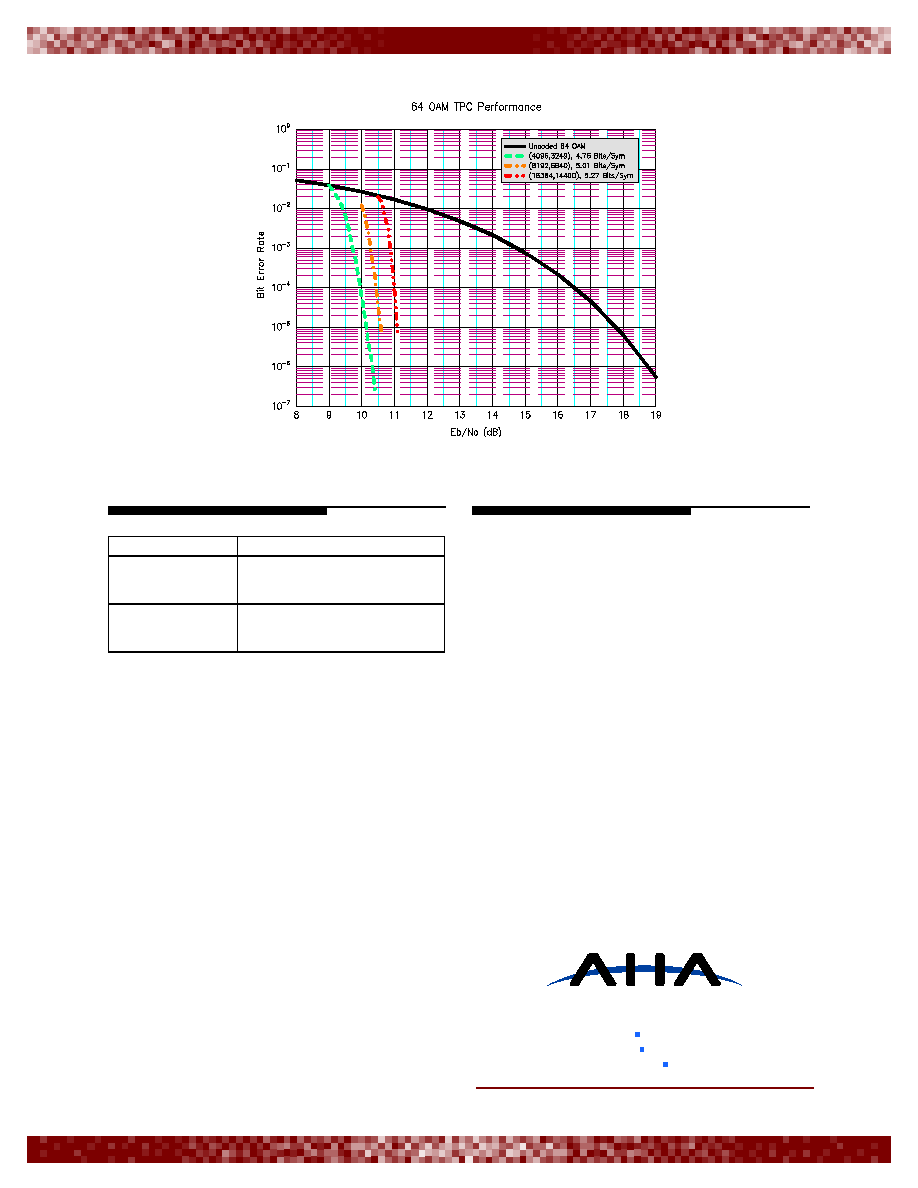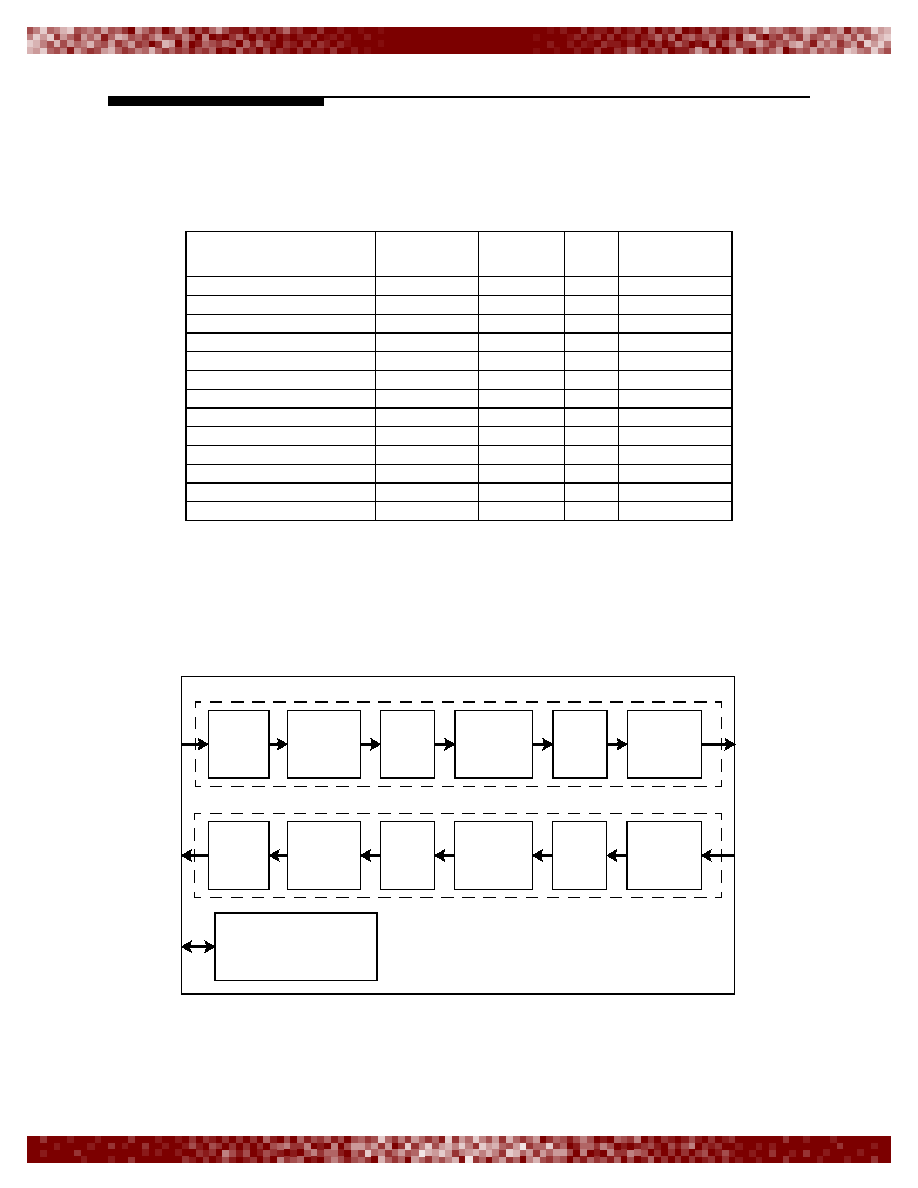
This product is covered under multiple patents held or licensed by Comtech AHA Corp.
This product is covered by a Turbo Code Patent License from France Telecom - TDF -
Groupe des ecoles des telecommunications.
*Request the AHA4541 Product Specification for complete details.
comtech aha corporation
comtech aha corporation
PRODUCT BRIEF*
AHA4541
311 MBITS/SEC TURBO PRODUCT CODE
ENCODER/DECODER
The AHA4541 device is a single-chip Turbo
Product Code (TPC) Forward Error Correction
(FEC) Encoder/Decoder capable of 311 Mbit/sec
data rates (up to 360 Mbit/sec channel rates). This
device integrates both a TPC encoder and decoder,
and can be operated in a full duplex mode. In
addition to TPC coding, support is included for
helical interleaving, synchronization mark insertion
and detection, CRC computation, scrambling, and
higher order modulation symbol mapping. Figure 1
shows the functional block diagram.
The channel interface supports direct
connection to various modulators and demodulators.
Support for an arbitrary constellation mapping is
included with external logic.
The encode path accepts byte-wide data,
computes and inserts a CRC, and scrambles the data
before TPC encoding. After the error correction
code (ECC) bits are inserted by the encoder, the data
is helically interleaved, and block synchronization
marks are inserted to assist the decoder. Finally, the
data is mapped according to the constellation and
output from the device.
The decoder accepts input symbols via the
demodulated in-phase (I) and quadrature (Q)
components or alternately as soft metric inputs from
an external demodulator. An internal block
synchronizer searches for synchronization marks,
rotating the input symbol phase as necessary. After
synchronization is achieved, the data is helically
deinterleaved and decoded by the TPC decoder. The
output of the decoder is descrambled, and the CRC
is computed to verify data integrity. Decoded data is
output in a parallel, byte-wide fashion.
Internal circuitry enables the transfer rate across
all ports, generating a constant, non-burst data flow.
In addition, control of an external VCO can be used
to generate data clocks, greatly simplifying system
clocking issues.
FEATURES
PERFORMANCE:
· Maximum 360 Mbit/sec channel rate
· Payload data rates of at least 311 Mbit/sec for
code rates >0.86
· Symbol rates up to 90 MSym/sec
· Encode Latency of less than 10 clocks
· Integrated encoder/decoder;
scrambler/descrambler; and
interleaver/deinterleaver for full duplex operation
· Supports enhanced Turbo Product Codes (eTPCs)
· Corrections count and averaging for channel SNR
estimation
FLEXIBILITY:
· Code Rates from .25 to 0.98
· Variable iterations up to 256 per block
· Block Sizes from 256 bits to 16 Kbits
· Programmable code shortening supports exact
block sizes
· 32 bit CRC Insertion and Checking with
programmable packet length
CHANNEL INTERFACE:
· Accepts in-phase and quadrature (I & Q) inputs,
up to 8 bits each
· Supports soft metric inputs at up to 4 soft metrics
of 4 bits each
· Soft metric computation for BPSK, QPSK, 8-
PSK, 16-QAM, 64-QAM, and 256-QAM
· Supports additional modulation formats with
external logic
· Encoder and decoder pass through modes
· Programmable packet and block level
synchronization
· Automatic phase ambiguity resolution
· Supports insertion and detection of sync marks up
to 32 bits in length
· 8-bit Parallel Data Input/Output
· Support for external VCO to generate data clocks
OTHERS:
· Intel or Motorola microprocessor interface
· 3.3V I/O, 1.8V core operation
· Commercial or Industrial temperature rating

comtech aha corporation
FUNCTIONAL OVERVIEW
The channel encoder is designed to input data in
a byte-wide fashion. This data is CRC encoded and
randomized before coding by the TPC encoder.
Synchronization marks are then inserted into the
data before it is mapped to a user programmable
constellation. The blocks may be bypassed if not
needed.
Each symbol for modulation is output
synchronous to the transmit clock, with one symbol
transferred for each rising edge of the clock. The
format for output data depends on the modulation
format chosen.
The channel decode data path begins with
received symbols input to the device synchronous to
the receive clock, with one symbol transferred per
rising edge.
When using internal soft metric computation,
the input data is an I and Q sample value for the
given symbol. The soft metric computation engine
converts each I and Q sample to the soft metrics
required by the TPC decoder.
When soft metric computation is disabled, the
input data is a soft metric value for each bit in the
TPC block with up to 4 bits transferred on each
clock edge. Each bit would consist of up to 4
confidence bits per data bit. If enabled, all
synchronization is controlled by the device
including phase ambiguity resolution. Output is in a
byte wide fashion with packet start, end and error
signals.
CODE PERFORMANCE
Figure 2:
Bit Error Rate (BER) Performance (simulated) on a QPSK Channel
bpsk_oc3

comtech aha corporation
PB4541_0104
© 2004 Comtech AHA Corp.
comtech aha corporation
2345 NE Hopkins Court
fax: 509.334.9000
tel: 509.334.1000
e-mail: sales@aha.com www.aha.com
Pullman, WA 99163-5601
A subsidiary of Comtech Telecommunications Corporation
Figure 3:
Performance (simulated) of Several Codes on a 64 QAM System
ORDERING INFORMATION
ABOUT AHA
Comtech AHA Corporation (AHA) develops
and markets superior integrated circuits, boards,
and intellectual property core technology for
communications systems architects worldwide.
AHA has been setting the standard in Forward Error
Correction and Lossless Data Compression
technology for many years and provides flexible,
cost-effective solutions for today's growing
bandwidth and reliability challenges. Comtech
AHA Corporation is a wholly owned subsidiary of
Comtech Telecommuncations Corp. (NASDAQ:
CMTL). For more information, visit www.aha.com.
64qam_oc3
PART NUMBER
DESCRIPTION
AHA4541A-PQC
311 Mbit/sec Turbo Product Code
Encoder/Decoder - Commercial
Temp
AHA4541A-PQI
311 Mbit/sec Turbo Product Code
Encoder/Decoder - Industrial
Temp



